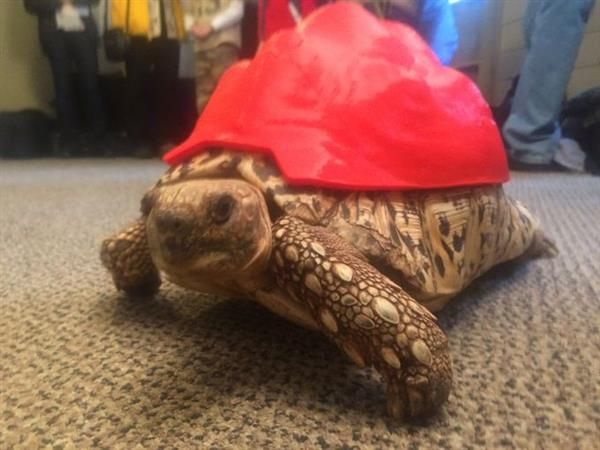Rescued pet tortoise gets new lease on life with 3D printed shell

A leopard tortoise suffering from malnutrition and a deformed shell has just received a brand new, 3D printed prosthetic shell that could extend the teenage pet’s life well into her 80s.
We all know that when it comes to our families and ourselves, a balanced diet is the key to a healthy lifestyle. Sadly, house pets don’t always receive the same care and attention. That was the case for Cleopatra, a young leopard tortoise who was mistakenly fed a protein-heavy diet for several years, leading to a condition known as “pyramiding,” signaled by a weakened shell with deep valleys and pyramid-like peaks in place of the strong, smooth shell of a healthy tortoise.
Rescued by Nico Novelli of the Canyon Critters Rescue in Golden, Colorado, Cleopatra is now back on a healthy diet of dandelions and cactus, which will eventually help to smooth and flatten-out her shell. In the meantime, however, she is still at risk. Her weakened shell leaves her exposed to harmful bacteria and infections, while pressure points caused by the raised pyramids mean that if another tortoise climbs on her back (a normal activity known as ‘roughhousing), she could be injured. Tortoises also use their smooth shells to help right themselves if they flip, but Cleopatra’s pyramids would prevent her from getting back on her belly.
Roger Henry, a student at Colorado Technical University, decided something had to be done: “I heard this tortoise was damaged, needed some help, and it seemed like the right thing to do,” he said.

He then spent hundreds of hours—about 600, to be precise—working with CAD software and several prototypes in order to develop a 3D prosthetic shell that fits perfectly overtop of her existing one. The strong, smooth prosthetic, printed from a biodegradable corn-based plastic, behaves just like a healthy tortoise’s shell would, protecting her from infection and other tortoises while allowing her real shell to properly heal underneath. It is lightweight enough that Cleopatra won’t even notice its presence, and is easily secured with a Velcro strap.
The secret in getting the new shell to fit just right was to adjust the influence of gravity in the design software so that it would “drape” over the tortoise like a piece of cloth. Once Henry and his team had figured that part out, it was just a matter of taking the mold to The 3D Printing Store in nearby Denver and having it 3D printed. The shop, owned by Debra Wilcox, donated their resources in order to make Henry’s vision a reality. "It's fantastic to know this tortoise is going to be able to recover from its malnutrition," Said Henry.
Since Cleopatra is only in her teenage years now, she is expected to grow two or three times her current size—especially now that she’s back on a healthy diet. Luckily, the rapid-prototyping made possible by 3D printing means that as she grows, new prosthetics can be scanned and printed until she is fully healed. Additional modifications, such as ventilation holes, will also be added to any new iterations.

Colorado is quickly becoming a central hub for 3D printing manufacturers and makers. “Colorado is at the precipice of being the premier location for additive manufacturing,” said Wilcox of The 3D Printing Store. “A lot of industries are using a manufacturing process that is 50 years old, that can and will be both cost-effectively and time-effectively replaced by 3D printing.” From rescuing mistreated reptiles to saving human lives to leading the next manufacturing revolution, we’ll be keeping an eye on what the 3D printing community in and around Colorado will be up to next.







